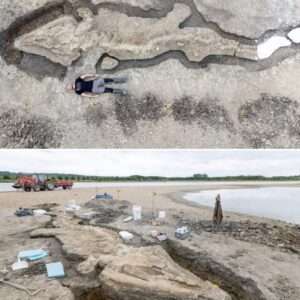Hunger stones, an intriguing historical phenomenon scattered across Europe, particularly in the Czech Republic and Germany, have captivated the attention of historians and environmental enthusiasts alike. These large inscribed stones emerge during times of drought, revealing poignant messages that narrate the tales of hardships and famines experienced by communities in the face of water scarcity.
The Elbe River’s Grim Reminder: Among these hunger stones, one stands out prominently along the banks of the Elbe River, near the Czech town of Decin. Carved in 1616, this particular hunger stone bears a haunting inscription that translates to “Wenn du mich siehst, dann weine” – a chilling plea that means “If you see me, weep.” This stark message serves as a somber reminder of the devastating consequences of drought and famine on the local population during that era.

Historical Insights: Hunger stones offer a unique perspective into the historical impact of climate variations on societies. As silent witnesses to centuries of environmental challenges, these stones serve as markers for low water levels, preserving the collective memory of communities facing adversity. The inscriptions not only document the struggles of the past but also emphasize the resilience and adaptability of human societies in the face of nature’s unpredictable whims.
Environmental Interest and Awareness: Beyond their historical significance, hunger stones have sparked environmental interest. Researchers and environmentalists study these stones to gain insights into past climate patterns and the effects of water scarcity on societies. In an era where climate change is a pressing concern, hunger stones serve as poignant reminders of the intricate relationship between humans and the environment, urging us to reflect on the importance of water resources and the potential consequences of their scarcity.
Conclusion: Hunger stones, with their cryptic inscriptions and historical tales, provide a captivating glimpse into the challenges faced by our ancestors during periods of drought and famine. As we marvel at these stones, we are reminded not only of the resilience of past societies but also of the urgent need to cherish and protect our water resources in the face of an ever-changing climate. The hunger stones stand as silent sentinels, encouraging us to learn from the past and to safeguard our environmental heritage for future generations.





